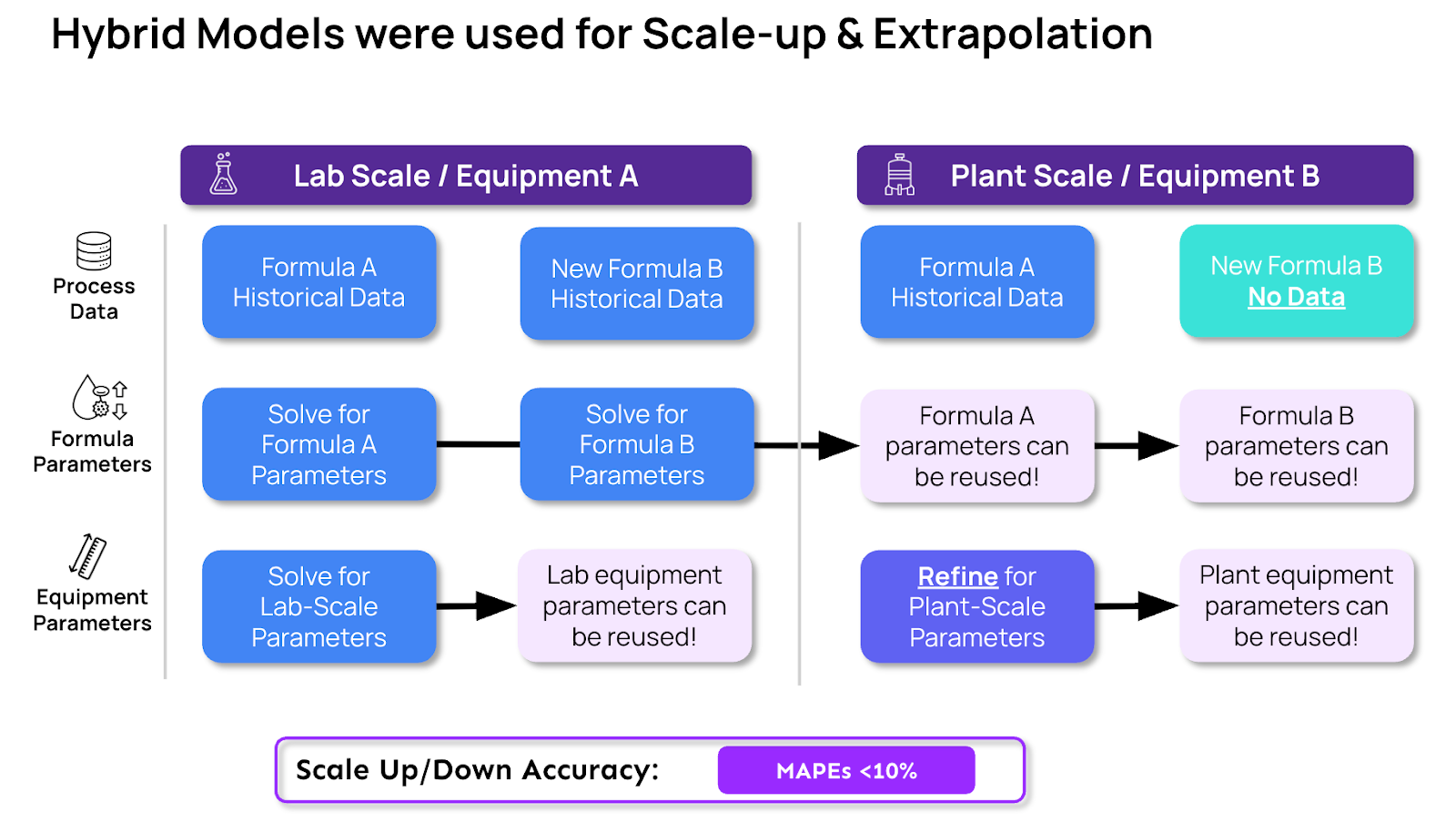The Scale-Up Problem: Process Scale Up Challenges
Scaling up manufacturing processes, from lab bench to pilot or full production scale, is a major challenge. Physical trials at larger scales are often time-consuming, expensive, and inefficient. Small differences in equipment, mixing speeds, or temperature can result in significant variability in product quality, consistency, or performance.1
Traditional scale-up relies heavily on trial-and-error, which slows innovation and increases costs.2 Manufacturers need reliable ways to predict process outcomes at scale without conducting dozens of costly physical experiments.
The Data Problem: How to scale up processes with limited data
When looking to improve the efficiency of their scale up, manufacturers often turn to virtual simulations, or digital twins, to determine the optimal SOPs for maintaining quality yield.
Yet when modeling these processes, they are often left with a question: how can I accurately simulate a scaled-up process when data at the new production scale is limited or sparse?

Simulation models require detailed information about how materials behave under varying conditions, such as mixing speed, shear rate, temperature, viscosity, and particle size distribution (PSD).
Without sufficient data, simulations risk being inaccurate or overly simplistic, failing to reflect the true behavior of the process at scale. This leaves manufacturers dependent on costly experimental work and limits the ability to optimize processes efficiently.3
The Solution: Scaling Up Using Prior Formulation Data
Basetwo has developed an approach to scale-up that is built on reusing and adapting insights from prior processes. By combining mechanistic modeling with machine learning, Basetwo enables organizations to predict how different formulas will behave when transitioning across equipment types or production scales.
The approach begins with lab-scale data, where process parameters are solved for each formula individually.
Once established, these formula-specific parameters can be reused and adapted at a larger scale, reducing the need to start from scratch when data for new formulas is limited or unavailable.
Equipment-specific parameters are also refined and transferred between scales, ensuring that models remain grounded in the realities of different operating environments.

By embedding these formula- and equipment-specific parameters into predictive models, manufacturers are able to run virtual experiments, anticipate scale-up risks, and identify optimal conditions, accelerating development while minimizing reliance on costly and time-consuming physical trials.
Scale Up Simulation Examples
How to Scale up Cosmetic Emulsions: A Hybrid Approach
Cosmetic emulsions often behave differently when moving from the lab to production scale. Droplet size, viscosity, and stability can shift because mixing speeds, shear rates, and energy dissipation change in larger vessels.4 To manage these challenges, researchers recommend hybrid scale-up methods that combine physics-based models with calibration from experimental data.1
The process usually begins with detailed lab data—such as droplet size distributions, viscosity curves, and temperature profiles. This information is then used to adjust equipment-specific simulation models so they better reflect how a particular formulation responds to mixing.5
Once calibrated, the simulations can predict how emulsions will behave at larger scales and highlight which mixing speeds, temperature ranges, or vessel configurations will keep the product consistent. Running these virtual experiments allows manufacturers to test options before committing to costly full-scale trials, cutting down on failed batches and speeding up development.6
Digital Twins for Scaling up Small Molecule Processes
When scaling up a small molecule synthesis, the challenges are often less about mixing aesthetics and more about controlling reaction kinetics and heat transfer.
A reaction that is perfectly selective in a 100 mL flask can behave very differently in a 100 L reactor: hot spots may form, impurities can spike, or crystallization can shift unexpectedly.7
To address this, scientists can leverage digital twins calibrated with lab data to predict how changes in agitation, cooling capacity, and solvent choice will affect yield and purity.8
These models allow teams to test scenarios virtually, such as different reactor geometries or temperature ramp rates, before running physical experiments.
As a result, companies can pinpoint operating conditions that deliver consistent product quality, shorten tech transfer timelines, and reduce the costly trial-and-error traditionally associated with small molecule scale-up.9
Conclusion
By combining mechanistic modeling, machine learning, and prior process data, manufacturers can overcome the dual challenges of sparse data and scale-up uncertainty. This approach enables accurate virtual experimentation, process optimization, and reliable prediction of product quality at larger scales. As a result, manufacturers are able to reduce costs, accelerate innovation, and ensure consistent product performance.
To explore Basetwo’s approach for your process scale up, reach out today.
References:
- Schuchmann, H.P. (2011). Emulsification processes: Scale-up and challenges. Chemical Engineering & Processing, 50(10), 1006–1016.
- Horvath, C., et al. (2015). Digital methods for chemical process scale-up: A review. Chemical Engineering and Processing, 97, 1–15.
- Perera, S., & Johansson, B. (2017). Data quality problems in discrete event simulation of manufacturing systems. Procedia CIRP, 60, 1–6.
- Floury, J., Desrumaux, A., & Axelos, M.A.V. (2004). Effect of high pressure homogenization on structure and stability of emulsions. Food Hydrocolloids.
- Hall, S., Cooke, M., & Carpenter, K. (2011). Emulsification in rotor–stator mixers: Scale-up studies. Chemical Engineering Science.
- AIChE Annual Meeting (2019). Defining a scale-up strategy for oil–water cosmetic emulsions.
- [2] Schaber, S.D., et al. (2011). Economic analysis of integrated continuous and batch pharmaceutical manufacturing: A case study. Industrial & Engineering Chemistry Research, 50(17), 10083–10092.
- Kralisch, D., Kreisel, G., & Ott, D. (2013). Process intensification and process design in chemical engineering: Challenges and opportunities. Chemical Engineering and Processing, 67, 1–19.
- Schweidtmann, A.M., et al. (2018). Machine learning in chemical engineering: Strengths, weaknesses, opportunities, and threats. Computers & Chemical Engineering, 110, 106–114.



